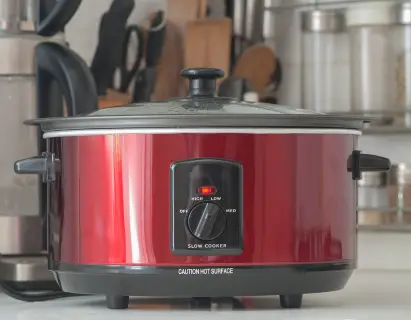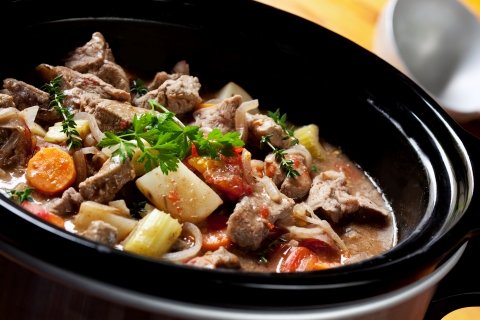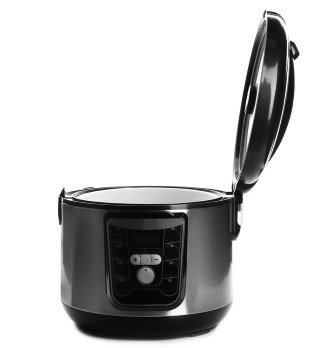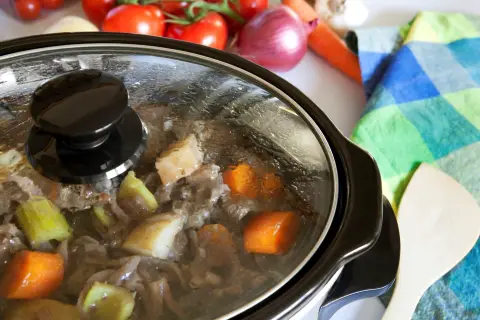Are you in the mood for some classic chili or stew? If your answer is ‘yes,’ then there is no better way to cook than using a crockpot or slow cooker. When it comes to cooking meat, not only does a crockpot help save time and effort, but it also ensures that the meat is soft, tender, and juicy. If you’re new to using a slow cooker, you may notice that the food starts bubbling after a point. This may make you wonder: Is it supposed to be doing that? Moreover, is it better to slow cook on high or low on a crockpot?
Read this detailed guide to answer all your essential crockpot-related questions.
Table of Contents
Is a Slow Cooker Supposed to Bubble?
Yes, food cooked in a slow cooker may start bubbling or simmering after a certain while. As a slow cooker provides direct heat during a longer cooking time, this builds up steam inside the crockpot and the simmering process begins.
While your food is supposed to bubble in a crockpot, you need to be able to differentiate between simmering and boiling. If you let the dish simmer or bubble for a long time, it will eventually start boiling because the liquid has reduced to an amount that gets the temperature to boiling point, which is 212°F. When you see a little bubbling on the surface, it is still considered a simmer. Rapid bubbling, on the other hand, is a clear-cut sign of boiling.
The general rule of thumb is to slow cook your food in a crockpot for 2 to 5 hours maximum on a low heat setting. After this point, there is a high chance that your food will start boiling, and you will notice rapid bubbling. If you set the cooker to high, boiling will start earlier.
Typically, a crockpot on slow settings should only simmer the food, not boil it. Ultimately, it all comes down to the cooking time, the type of food you are cooking, and the nature of bubbling that you notice; you need to consider all these factors to determine if your food is simmering or boiling inside the crockpot.
How Can I Tell if My Crockpot Is Working?
You can tell if your crockpot is working or not by checking the temperature. As per the U.S. Department of Agriculture’s Food Safety and Inspection Service, a standard crockpot should maintain a temperature range of 170 to 280 degrees Fahrenheit. If your crockpot food falls within this temperature range, you can sigh in relief as this indicates that your crockpot is working correctly.
Note that older crockpots may take longer to heat up than new ones. As long as the slow cooker reaches 170 to 280 degrees Fahrenheit, you are good to go.
Pro tip: Fill 75% of your crockpot with room temperature water and set the setting to low. Use a food thermometer to check the temperature after 6 to 8 hours; if it reads at least 185 degrees Fahrenheit – your crockpot is working perfectly.
How Long Does It Take a Crockpot to Heat Up?
The standard time is 6 to 8 hours for heating a crockpot on a low setting. If you set up your crockpot on a high setting, the heating time will reduce to 3 to 4 hours. The heating time also varies based on the model of your crockpot and its heating technology.

While a crockpot may get the job done, remember that it is not the ideal device for reheating food; it is primarily used for slow cooking. There are separate small crackpots on the market that are used primarily for keeping party dips and sauces warm.
If you wish to reduce cooking time, you can pre-heat your crockpot for at least an hour before adding any ingredients. Another tip is using the high setting for the first hour to reduce the cooking time. This method is recommended when cooking a time-consuming meat or poultry dish.
Can a Crock Pot Boil Water?
Yes, you can easily boil water in a crockpot. It will typically take 2 to 3 hours to boil water on a high setting and 4 to 6 hours when the crockpot is set to low.
A few factors, such as the quantity of water, the model of your crockpot, crockpot settings, etc., come into play when determining the boiling time. The water will start to simmer first and after a few hours will reach the optimum boiling temperature of 212°F.
Why is My Slow Cooker Not Boiling and How Do I Fix It?
Before we delve into why your slow cooker won’t boil, it is imperative to understand how slow cookers work. The latest models of crockpots usually come with the following settings:
1. Warm – the temperature is around 167 degrees Fahrenheit
2. Low – the temperature is around 190 degrees Fahrenheit
3. High – the temperature is around 300 degrees Fahrenheit
Both ‘Warm’ and ‘Low’ temperatures are below the boiling point of water, so it is recommended to use the ‘High’ setting for boiling.

We will now explore the reasons why a slow cooker may not boil and how you can fix it.
You Have Chosen an Incorrect Setting on the Crockpot
As mentioned earlier, you must set your crockpot setting to ‘High’ if you want the food to boil. The keep-warm setting is only to keep already cooked food warm until you’re ready to eat. The low heat setting is ideal for slow-cooking tough meats and cuts or when you want the food to simmer for a long time.
As we’ve said, the low and warm heat settings provide temperatures below boiling point and low is the simmer setting on a crock pot. So, if your crockpot is not set to high, you can change the setting and wait for at least 2 to 4 hours for your crockpot to start boiling. However, when cooking tough meats, it is not recommended to use the high setting as it may dry out the protein.
You can also aim for boiling by setting your crockpot temperature to low and letting it simmer for at least 6 to 8 hours or longer to ensure that the meat in your crockpot remains tender and juicy.
You are Lifting the Lid of Your Crockpot
If you habitually lift the lid of your crockpot from time to time to taste test or stir the ingredients, you are most likely to have difficulty trying to boil food in it. Maintaining a consistent temperature inside the crockpot is imperative, especially if you wish to reach the boiling point.

As soon as you open the lid, the temperature inside the crockpot drops and the trapped heat and moisture are also released. Keep in mind that whenever you remove the lid, it increases the boiling time by about half an hour. You also risk food contamination if the temperature doesn’t reach the safe zone fast enough, which is something to be aware of when slow cooking on the low setting.
When the crockpot is set to low, it increases the temperature at a slow rate. Therefore, in order to maintain this gradually increasing temperature, the lid of the crockpot must not be removed.
Your Crockpot is Overfilled
Ideally, your crockpot should only be half or three-quarters filled with ingredients for best results. If you overfill your crockpot, it is more likely to take a longer time to boil. This includes having too much liquid in the pot. Even if the food has come to a boil, if the amount of liquid hasn’t been reduced enough by the end of cooking, your dish will taste watery and bland.
Therefore, please ensure you follow the recommended settings and do not overfill your crockpot if you wish to boil or simmer food.
Your Crockpot Has Malfunctioned
If you follow the tips mentioned above and are still unable to boil food in your crockpot, it could be because there is something wrong with it. It could either be a faulty component or a wiring issue or the slow cooker thermostat that may cause this problem.
In this case, you should immediately contact customer care of your crockpot’s manufacturer and get your crockpot fixed, that is if it is still eligible for a warranty claim. Otherwise, it would be best if you took it to any reputed electronics store for repair.
Can You Get Food Poisoning From Slow Cooker?
Yes, it is possible to get food poisoning from slow cookers. As they use low temperatures for cooking, if you add frozen ingredients to the pot it increases the overall cooking time. This puts you at risk, as the longer it takes to cook, the higher the chance of the food not reaching a safe temperature in a reasonable amount of time.
This is why it is not recommended to put frozen vegetables or meat directly into your slow cooker, as it comes with the potential risk of food poisoning.
Why Does My Slow Cooker Cook So Fast and How Do I Fix It?
If the slow cooker is burning food and taking very little time to cook, read on to find out why that is happening and how you can fix it.
Not Enough Moisture in the Ingredients
If you are adding ingredients that are dry in nature, they may easily burn inside a slow cooker. A slow cooker needs moisture to cook food for longer durations. Therefore, adding ingredients that release natural moisture like meat, vegetables, etc., is always recommended to ensure your food does not burn.
For best results, layer up vegetables like celery, leek, and onions at the bottom of your slow cooker before adding any meat or protein on top. You may also add half or a full cup of water to your slow cooker to ensure enough moisture inside for the food to cook all the way through.
Your Slow Cooker Has Faulty Components
If your slow cooker has faulty components like a loose switch, broken thermal fuse, or heating element, it could cause the temperature to fluctuate between high and low or off, which might end up burning your food. In this case, immediately contact your slow cooker’s manufacturer or take it to an electronics store for repair.


